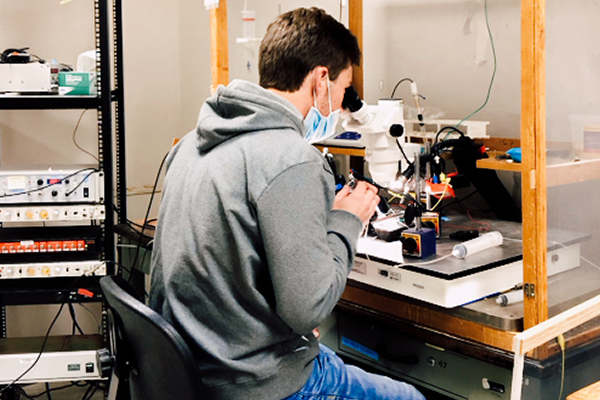Team Bird Brain’s undergraduate and graduate students come together under the mentorship of Pilarski, who says, “It’s really about the students for me. I have really enjoyed training students in the lab and over the last eight years we’ve had some incredible students.”
When you talk to students in his lab, you realize Pilarski isn’t blowing smoke. The procedures mentioned above are no small feat to master, and Pilarski entrusts his students in learning how to do it.
“First you have to be able to recognize the nerves, then you have to recognize good nerves and then you actually have to find them again and record (from) those,” said Jennie Nelson, an undergraduate biological science student who has worked in the lab the last 2-1/2 years and is entering a neuroscience doctoral program at the University of Utah this fall, thanks in no small measure to her experience in the lab.
“It is a pretty complex thing that you do under a microscope,” Nelson continued. “You could not tell what the smaller embryo brainstems are without a microscope because they are about the size of the end of a sharpened pencil – they are very tiny.”

Jaydn Burton
Another undergraduate in the lab, Jaydn Burton, a biological sciences major who graduated this spring and is entering the Idaho Dental Education Program this fall, said the experience doing the nerve procedures was invaluable.
“It is really good for pre-dental students because it is very minute work on those tiny, little Zebra Finch brainstems, that are about the size of Lincoln’s head on a penny,” said Burton, who said it took him months to master the procedure. “Then we work with the nerves on them, which are microscopic and you can barely see them. You get really good practice with microscope and hand-eye coordination that way.”
Says Pilarksi, “It is hard for undergraduates to do neuroscience research. It requires so much time and they have a full schedule so I don’t know how it all happens, but it works out.”
Students and Pilarski agreed that the lab has had good chemistry throughout the years with students working with each other.
“I don’t know if it is the students Dr. Pilarski picks or it is the students who want to come in, but we’ve been able to work so well as a team,” Nelson said. “Because I am a nontraditional student, I am 33 years old, I’ve worked different jobs before. Having a team that isn’t a team is no fun. Team Bird Brain works together so well, it is absolutely awesome to work there.”
Students in the lab have the opportunity to be authors and co-authors on papers, a boon for students continuing in research or health-related fields. Pilarski said that six of the students that have worked in the lab have been either first authors or co-authors on peer reviewed published scientific papers.
The uniqueness of the lab’s work also adds to its appeal.
“What is really rewarding for me is just the aspect of discovery,” Whitaker said. “So our lab, to my knowledge, is the only lab, at least in the country, that is studying the early rhythms in the Zebra Finch brainstem. So any day I am going into the lab and doing an experiment, I can actually be the only person doing that in the whole country and maybe making a new discovery.”
In their quests for making new discoveries, the students are given a long leash and their input is valued and encouraged, both Whitaker and Nelson said.
“He asks us to come up with our own hypothesis before even telling us what they should be,” Nelson said, “that way we start thinking about how to do things then he will help us along. He does not just give it to you, which is awesome.”
The lab is also an interesting crossroad. Pilarski holds a dual appointment in the ISU Biological Sciences and Dental Sciences departments.
“It is a cool collaboration between health sciences and biology,” Pilarski said. “It is more than just applied science or basic science and I think funding agencies like that. They like to see how you would translate basic science, even on another animal like a bird, into something that is useful for people.”
The lab has been useful for the students working in it to go in either direction as a career path, as exemplified by Nelson entering a Ph.D. research program and Burton entering the IDEP program.
“I think our lab is very good for both worlds,” Whitaker said. “Students have come in with both of those interests and I think they have the experience they need to go on and succeed.”
